Of the many Homoptera pests that infest citrus groves, only a few affect the health and productivity of a tree to a level where control measures are necessary. The first step in controlling any pest is correct identification. Without this, appropriate biological or chemical control measures cannot be selected. Inappropriate pest management tactics may fail to provide control of the target pest and/or disrupt existing natural control of other pests, leading to secondary pest problems. Most of the pests included in this article are under biological control by predators, parasites and pathogens, thus minimizing the need for pesticide applications.
Aphids
Aphids, like many other pests discussed in this document, produce live young asexually (without a requirement for sex). Asexual reproduction means that all individuals are female and populations can grow very rapidly. All aphids infest newly expanding citrus terminals exclusively, sucking sap from the growing leaves and stems. Two or more species may form mixed colonies. Aphid feeding does not cause significant damage to mature trees, but young tree growth may be affected by heavy infestations. Aphid infestations in nurseries cannot be tolerated and typically require chemical treatments. The honeydew excreted by aphids and other homopteran pests coats leaves and fruit, stimulating the growth of sooty mold. Generalist predators such as ladybeetles, hoverflies, and lacewings are the most important natural enemies of aphids in citrus. Aphid populations usually decline under high summer temperatures and during periods when new flushes are absent.
Brown Citrus Aphid, Toxoptera citricida (Kirkaldy)
Brown citrus aphid (BCA) is the most abundant aphid in Florida citrus and is the primary vector of citrus tristeza virus (CTV). Quick decline strains of CTV have already killed thousands of trees on sour orange and bittersweet rootstocks since the arrival of BCA in 1995 in Florida. BCA is specific, feeding only on citrus and closely-related rutaceous plants. Large colonies may form on new flushes (Figure 1) where they deposit large amounts of honeydew that subsequently stimulates the growth of sooty mold. Growing terminals may be stunted by high aphid populations and there is some indication that fruit set may be impacted when flowers become infested.
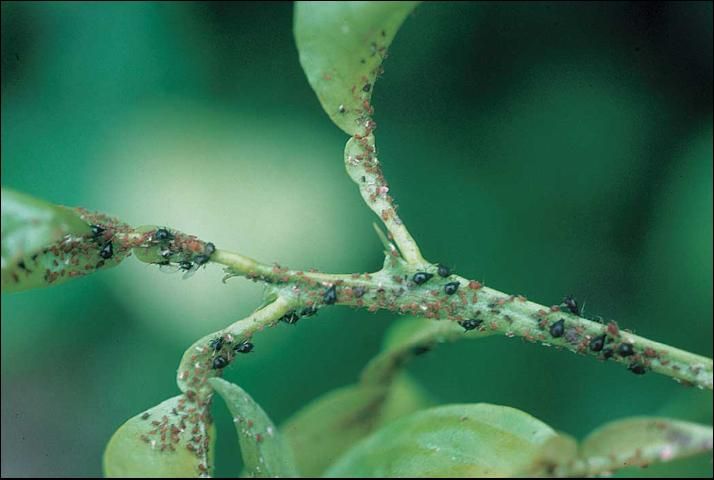
Credit: UF/IFAS CREC
Black Citrus Aphid, Toxoptera aurantii (Boyer de Fonscolombe)
The black citrus aphid is relatively rare in Florida citrus, since being displaced by the closely related species, the brown citrus aphid. Unlike the brown citrus aphid, it has a relatively broad host range, including many species of ornamental plants. Although similar in appearance to the brown citrus aphid, adult black citrus aphids have a dull black appearance (Figure 2). There are also differences in wing and antennal characteristics. This aphid is no longer economically important in Florida citrus.
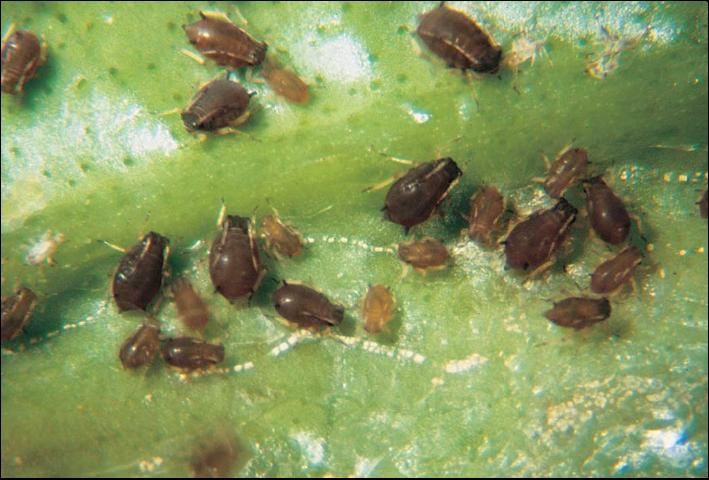
Credit: UF/IFAS CREC
Spirea or Green Citrus Aphid, Aphis spiraecola Patch
The green citrus aphid is quite small and its color matches that of the new flushes of citrus leaves on which it feeds (Figure 3). It has many host plants in Florida but can colonize citrus in large numbers. Although it is only a weak vector of CTV, its feeding causes permanent damage to growing citrus terminals. Injury is characterized by a shortening of internodes, cupping, and twisting of the leaves. Control measures are only required for heavy infestations in young groves.
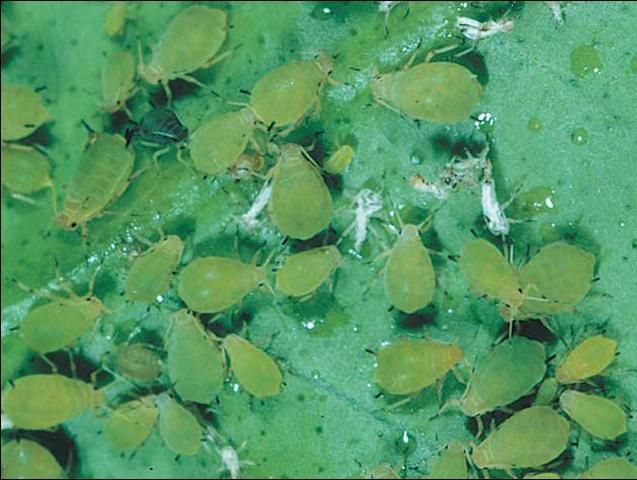
Credit: UF/IFAS CREC
Melon or Cotton Aphid, Aphis gossypii Glover
The melon aphid is another small aphid that varies in color from dark blue-green to pale yellowish (Figure 4). Many color forms may be present in the same colony. It has a wide range of host plants that make colonization of citrus somewhat unpredictable. It is second in importance only to brown citrus aphid as a vector of CTV and can sometimes be found in mixed colonies with both brown and green citrus aphids. The melon aphid is the primary host of Lysiphlebus testaceipes Cresson, a generalist aphid parasitoid that also causes mortality to brown and green citrus aphids.
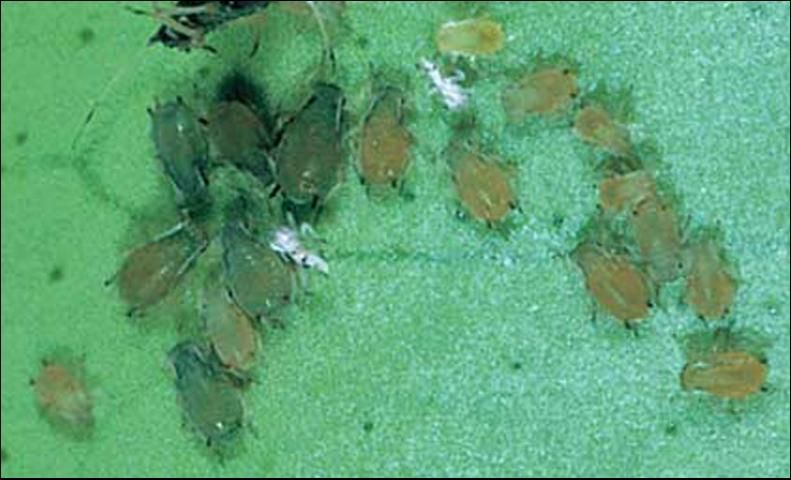
Credit: UF/IFAS CREC
Psylla
Asian Citrus Psylla, Diaphorina citri Kuwayama
The Asian citrus psylla (Figure 5) has been present in Florida since 1998 and only recently has spread northward to infest virtually all commercial citrus areas. Asian citrus psylla is the primary vector of Huanglongbing (HLB), or citrus greening disease. Adult psylla reproduce sexually and can survive for extended periods feeding on mature leaves, although they forego reproduction until new leaves become available. Eggs are laid only on newly flushing citrus terminals. Juvenile psylla deform these terminals as they feed, causing a distinctive pinching and twisting of the leaves, but without the shortened internodes characteristic of green citrus aphid damage. Psylla honeydew is waxy and viscous, forming curly white strands, but generates less sooty mold growth than the honeydew of aphids. The direct damage caused by feeding on young citrus terminals by psylla is permanent and heavy infestations on young, vigorously growing trees may warrant treatment.
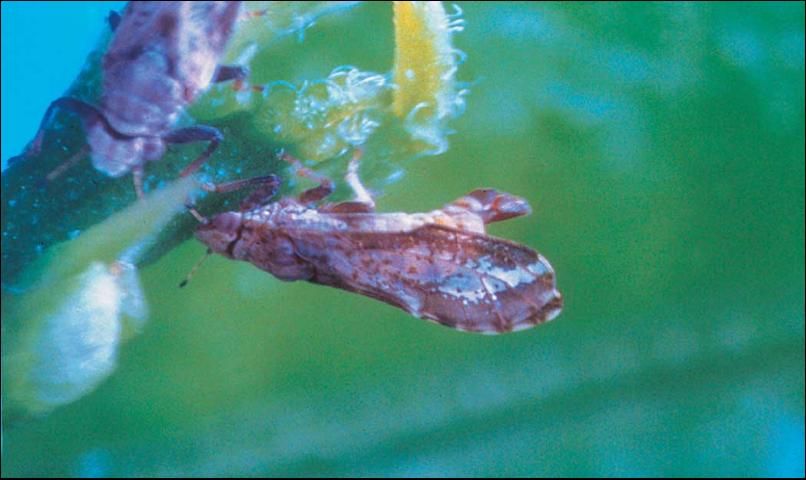
Credit: UF/IFAS CREC
Whiteflies
Whiteflies infest a wide range of host plants including citrus. Damage by citrus whiteflies is limited to the leaves where they feed using piercing sucking mouthparts and remove cell contents. Whiteflies are copious honeydew producers thereby supplying the leaf surface with a sugar source for sooty mold production. Large amounts of sooty mold can reduce the vigor of the tree resulting in reduced crops in extreme cases. Mature whiteflies are winged. Females lay eggs on the underside of the leaf, usually on immature leaves. Eggs hatch into crawlers that move to suitable feeding sites. Once the immatures (nymphs) begin to feed they become immobile and difficult to detect when in low number. Nymphs are oval, flat, and clear. Whiteflies have many natural enemies including the fungus, Aschersonia aleyrodis, that produces bright orange cadavers subsequent to infection, as well as many generalist predators and parasites.
Citrus Whitefly, Dialeurodes citri (Ashmead)
The adult whitefly is rather small, about 1-2 mm long and moth-like; males being smaller than females (Figure 6). The adult body is covered with a pair of wings, held more or less roof-like over the body and covered with a white waxy powder that lacks any distinguishing marks or pigmentation. The abdomen is yellow. The mated adult female will lay about 150 yellow stalked eggs in a random pattern primarily on the underside of leaves. Upon hatching, the nymphs are oval, thin and translucent (Figure 7). Pupae have visible eye spots and are similar in size to the nymphs but slightly thicker.
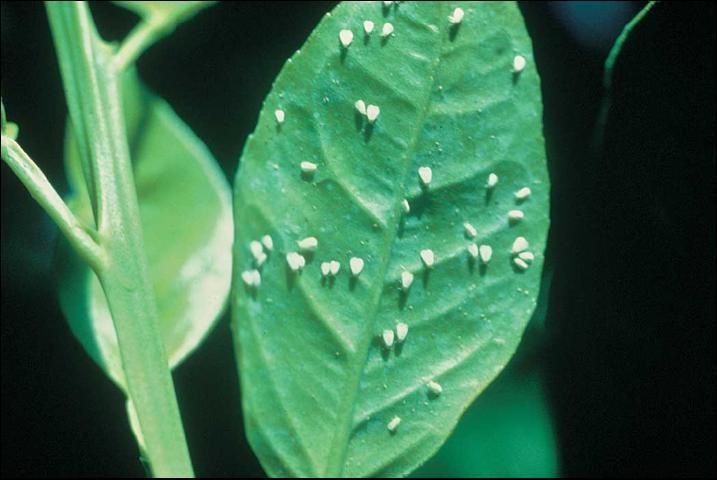
Credit: UF/IFAS CREC
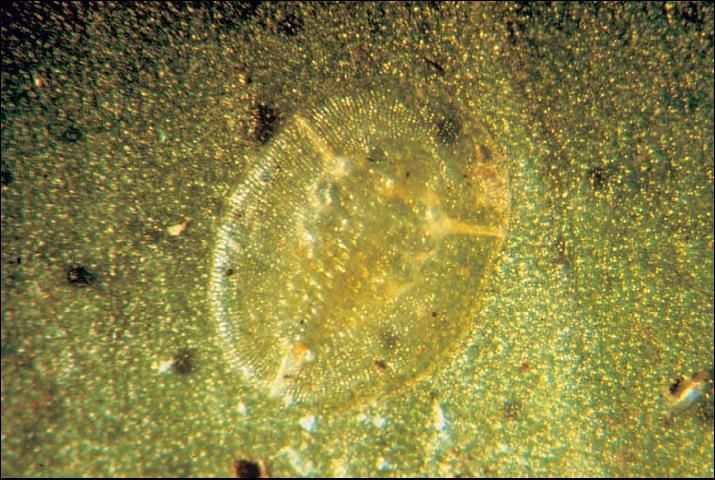
Credit: UF/IFAS CREC
Populations increase on spring and summer leaf flushes. Moderate to high populations are evidenced by a buildup of sooty mold which develops on the excreted honeydew. Whiteflies can be infected by a fungal pathogen, Aschersonia aleyrodis, which spreads rapidly when whitefly populations are high. Citrus whitefly is also attacked by aphelinid wasp, Encarsia lahorensis.
Cloudy-wing Whitefly, Dialeurodes citrifolii (Morgan)
The cloudy-wing whitefly and citrus whitefly are closely related morphologically and biologically. The adult cloudy-wing whitefly will have lightly shaded or cloudy areas on the posterior of the wings (Figure 8) and is slightly larger than the citrus whitefly. Adults of both species will congregate on young citrus leaves and reproduction is similar. The yellow stalked eggs of cloudy-wing whitefly will darken as they age. Nymphal stages are clear and extremely flat on the leaf surface. By the fourth nymphal stage, red eye spots and light colored wing buds can be seen.
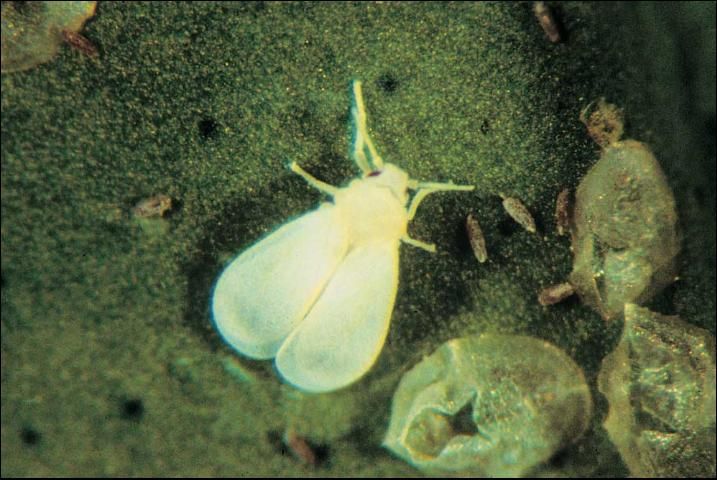
Credit: UF/IFAS CREC
Cloudy-wing populations increase on the spring and summer leaf flushes and can be found in mixed populations with the citrus whitefly. The adults also excrete honeydew followed by sooty mold development. Under high populations, the outer tree canopy can turn black due to sooty mold. Cloudy-wing white fly is susceptible to Aschersonia aleyrodis.
Bayberry Whitefly, Parabemisia myricae (Kuwana)
Bayberry whitefly is virtually unknown in Florida citrus. It is smaller than other whitefly species and about half the size of the citrus whitefly (Figure 9). It is pure white and generally found on newly developing flush. The eggs are dark in color and found on the leaf margin of both the upper and lower leaf surfaces. The hatching nymphs are extremely small, greenish-yellow, and have feeding habits similar to the other whitefly species. The bayberry whitefly can complete its life cycle in as little as 30 days when environmental conditions are favorable, allowing populations to develop very quickly.
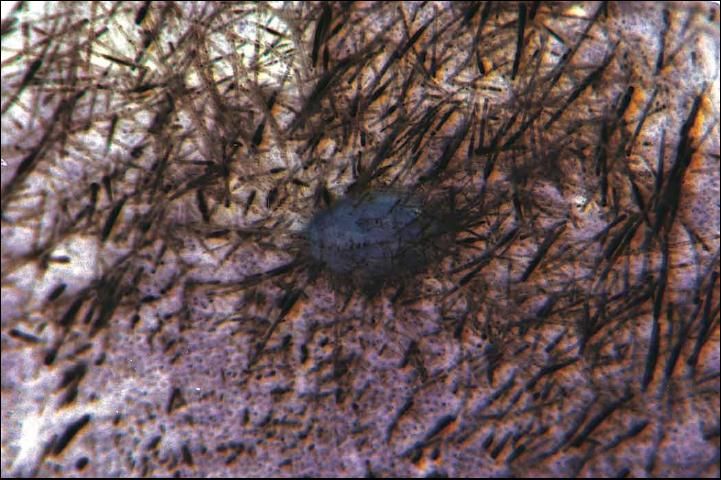
Credit: UF/IFAS CREC
Woolly Whitefly, Aleurothrixus floccosus (Maskell)
Adult woolly whiteflies are similar to other whitefly species and have unmarked wings. The female will lay eggs in clusters on mature leaves. The eggs are beige in color and attached to the leaf by a short stalk. When the nymphs emerge, they settle near the eggs and form a cluster. Early stages of the nymphs are light green in color and darken with each progressive molt and eventually turn brown in the final stage. The final nymphal stage is covered with fine waxy threads creating a woolly appearance (Figure 10).
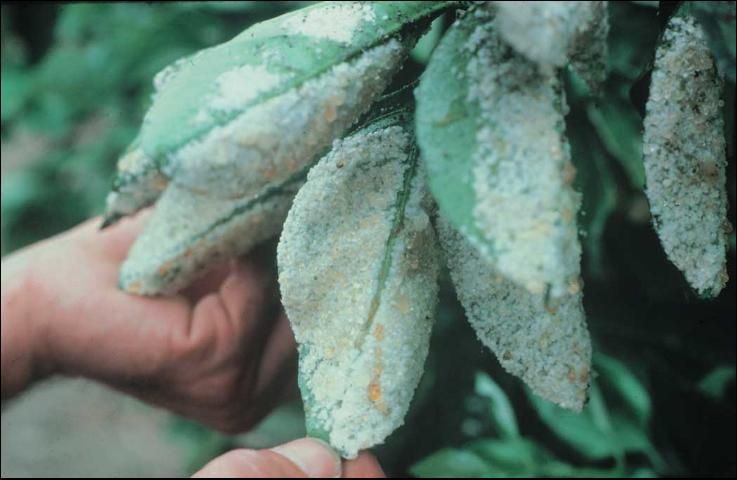
Credit: UF/IFAS CREC
Feeding by woolly whiteflies is typical of other whiteflies and they secrete large amounts of honeydew. The woolly whitefly is controlled by many different natural enemies, including parasitic wasps, ladybeetles, and fungi.
Citrus Blackfly, Aleurocanthus woglumi (Ashmead)
Citrus blackfly is the only species with all stages totally black (Figure 11) except for the yellow-orange eggs which darken with age. The adult female will lay up to 50 eggs in a spiral configuration on the undersides of leaves. This spiral configuration of egg masses is a key method of identification. The hatching nymph settles in the vicinity of the egg cluster on both mature and immature leaves. The nymphal stages have large bristles on the dorsal and lateral body surfaces. When the adults emerge they are bright red and become slate black with age. When populations are excessively high, nymphs will secrete large amounts of honeydew which supply a nutrient source for sooty mold fungi. Heavy infestations can cause rapid deterioration of trees and reduce future crops. Biological control by the parasitiods Encarsia opulenta and Amitus hesperidum are effective against this pest.
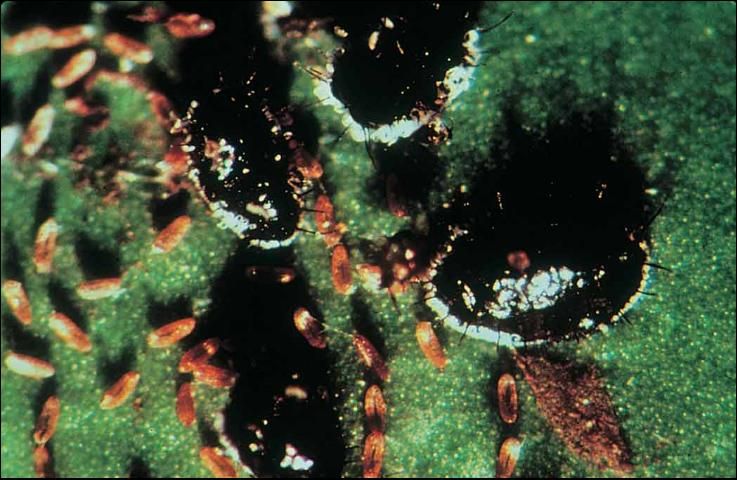
Credit: UF/IFAS CREC
Mealybug
Citrus Mealybug, Planococcus citri (Risso)
Citrus mealybugs are white with a segmented body. They are covered by a powdery wax covering (Figure 12). Underneath this covering is a yellowish, oval soft body. The wax covering will increase with age; the nymph having little wax and the adult heavily covered. The adult female is approximately 3 mm in length and will produce 300-600 eggs contained in a cottony mass. Eggs hatch in 6 days to several weeks, depending on environmental conditions. Nymphs are light yellow to cream in color. Upon maturity the male will develop wings and appear gnat-like, whereas the female will retain the nymphal form.
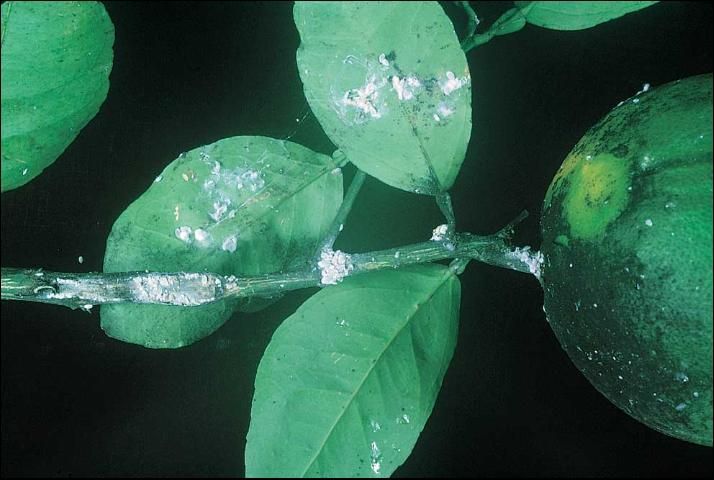
Credit: UF/IFAS CREC
Citrus mealybugs are most common in the spring and early summer. They prefer sheltered locations within the citrus tree and can be found in cracks and crevices in the bark, on fruit clusters or under the fruit calyx (buttons on the fruit). Like other scales and whiteflies, they produce large amounts of honeydew. Citrus mealybugs are usually under biological control provided by parasites and predators.
For more information on soft-bodied citrus insect pests, you may wish to consult the annual Florida Citrus Production Guide published by the University of Florida Institute of Food and Agricultural Sciences, Gainesville, Florida.